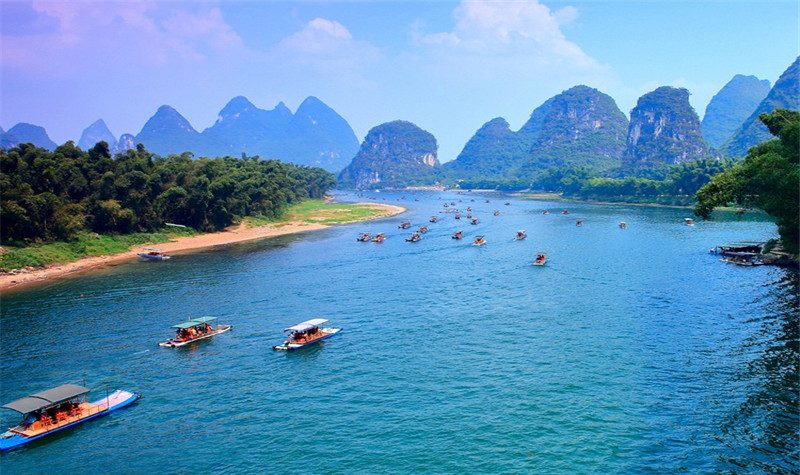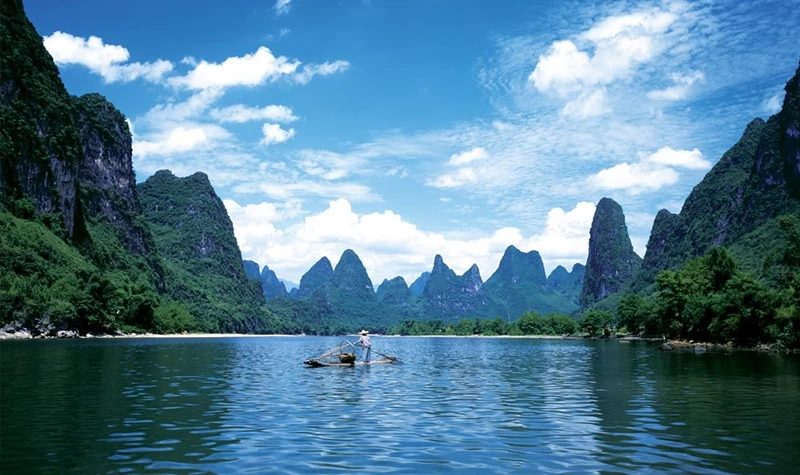The Li River, known as the soul of Guilin’s Mountains, is located in Guilin City, Guangxi Zhuang Autonomous Region, China, and is a beautiful section of the upper reaches of the Gui River, a tributary of the Xijiang River in the Pearl River Basin. Traditionally, it is believed that the source of the Li River is at Cat’s Hill on the Yue Cheng Ling (越城岭), while modern hydrology places its starting point at the mouth of the Ling Qu (灵渠) in the town of Sol River in Xing’an County, and its journey ends gracefully at the mouth of the Sanjiang (三江) River in Pingle (平乐). This meandering river flows through Xing’an, Lingchuan, Guilin, Yangshuo and Pingle, with a total length of about 164 kilometers (or 170 kilometers according to some accounts, which may be due to differences in measurements or historical changes), of which the 83-kilometer section of the river from Guilin to Yangshuo is the most essential and fascinating part of the Li River.

The Li River is world-famous for its unique karst landscape (i.e., strange peaks and rocks formed by limestone) and crystal-clear water. The riverbed along the river is covered with smooth pebbles and contains very little sediment, so the water is exceptionally clear and transparent. On both sides of the river are karst landscapes, with strange peaks towering and blue water gurgling, which reflect each other and form a picturesque landscape. When you take a boat trip on the Li River, you will be shocked by the scenery in front of you: the reflection of the strange peaks in the water, the turquoise river, the distant sound of the shepherd boy singing, the river surface of the idle fisherman fishing …… All this makes you feel as if you are in an earthly paradise.
Li River is not only a treasure of natural scenery, it also carries a deep history and culture. In the past, Li River was an important channel for water transportation between Lingnan and the Central Plains, playing a pivotal role in the unification of the country and economic and cultural exchanges. In the long history, Li River has nurtured rich cultural heritage and humanistic landscape. Nowadays, the Li River Scenic Area has been listed as a World Natural Heritage by UNESCO and rated as a national 5A-level tourist attraction, attracting tourists from all over the world to visit.

On the Li River, there are several classic landscapes that you can’t miss:
First is the “Nine Horses Painted Mountain”, the rock wall of this mountain has a natural pattern of nine horses, like a huge mural hanging in the sky, testing the imagination and observation of every tourist.
Next is the “Yellow Cloth Reflection”, where the river water is as clear as a mirror, and the peaks on both sides of the river are reflected in the water, which is clearly visible, just like an exquisite ink painting. It is worth mentioning that the pattern on the back of China’s 20 RMB is taken from the beautiful scenery here.
There is also Xingping Ancient Town, which is located by the Li River and has a long history, preserving the traditional architectural style and peaceful atmosphere. Here, you can stroll through the streets of the town, experience the local culture and take beautiful photos.

If you plan to visit the Li River, then the best time to visit is from April to October every year. This is when the weather is favorable and the scenery is at its best. You can choose to experience the traditional charm of the Li River by taking a bamboo raft to get a close-up view of the river’s clear water and the mountains; or you can choose to take a cruise to Yangshuo from Mopanshan Pier or Zhujiang Pier in Guilin, which lasts about 4 hours. The cruise offers food and beverage service and detailed explanations of the sights, making it ideal for families and groups of tourists. Whichever way you choose to visit the Li River, you will leave an unforgettable memory.
